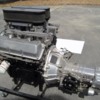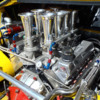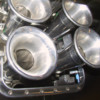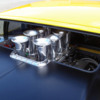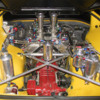This is what came with the car I just bought...but I haven't laid hands on it yet.
Looks like Halls set up with nitrous. I'd be interested to see what's in them.
If you need help with them send them here.
If you need help with them send them here.
I have posted this in a similar thread some time ago.
But here it is again.
A different take on the Weber look, using injection.
My Pantera runs fuel injection, 8 x 48mm throttle bodies.
Similar set up to Weber’s & a similar look.
This is an old “Pantera Performance center” kit I found on Ebay.
I assume from the 1980’s.
Velocity stacks I custom made, they are in two pieces where the top screws on to clamp in place a stainless mesh screen.
I have run the car with & without the screens on the Dyno & it made zero difference to the tune or power output.
Not that was easily noticeable anyway.
Computer is a Motec with crank angle sensor, TPS & MAP sensors only.
I rebuilt the throttle bodies & re-set the butterfly clearances.
Runs really nice, easy to start & reliable.
Combined with the 11:1 CHI 4V heads it made more responsive & snappier power.
I don’t run the car in the rain, nor do I wash the car with water.
The only issues I have had is balancing the throttle bodies to make sure they are all breathing the same amount at idle.
Also, because of the high air flow of 8 x 48mm butterflies it requires a corresponding amount of fuel when snapping the throttle open from idle.
So running rich at idle was causing the spark plugs to foul.
Re-tuning the car at idle & leaning off the fuel didn’t work, it simply backfired.
So now I have changed the Spark plugs from NGK BCP6ES to a hotter BCP5ES.
Yet to try it & see if it has cured the plug fouling problem.
The other issue is that each throttle body has its own return spring. And they certainly are required to get the butterflies to snap closed.
But combine the tension of 4 x springs & it makes a very stiff throttle pedal.
So at some stage I’m going to have to look at a progressive throttle linkage to gain some more leverage & better throttle control.
In regards to Vacuum.
I run an 8” dual diaphragm booster as my master cylinder is 1 1/8” bore, (4 piston rear calipers).
I also run a vacuum bottle up front with an extra check valve.
I tried supplying vacuum from one port & it was no where near enough.
So tried 2 ports, still not enough.
Then went to four ports & that was sufficient.
regards,
Tony.
But here it is again.
A different take on the Weber look, using injection.
My Pantera runs fuel injection, 8 x 48mm throttle bodies.
Similar set up to Weber’s & a similar look.
This is an old “Pantera Performance center” kit I found on Ebay.
I assume from the 1980’s.
Velocity stacks I custom made, they are in two pieces where the top screws on to clamp in place a stainless mesh screen.
I have run the car with & without the screens on the Dyno & it made zero difference to the tune or power output.
Not that was easily noticeable anyway.
Computer is a Motec with crank angle sensor, TPS & MAP sensors only.
I rebuilt the throttle bodies & re-set the butterfly clearances.
Runs really nice, easy to start & reliable.
Combined with the 11:1 CHI 4V heads it made more responsive & snappier power.
I don’t run the car in the rain, nor do I wash the car with water.
The only issues I have had is balancing the throttle bodies to make sure they are all breathing the same amount at idle.
Also, because of the high air flow of 8 x 48mm butterflies it requires a corresponding amount of fuel when snapping the throttle open from idle.
So running rich at idle was causing the spark plugs to foul.
Re-tuning the car at idle & leaning off the fuel didn’t work, it simply backfired.
So now I have changed the Spark plugs from NGK BCP6ES to a hotter BCP5ES.
Yet to try it & see if it has cured the plug fouling problem.
The other issue is that each throttle body has its own return spring. And they certainly are required to get the butterflies to snap closed.
But combine the tension of 4 x springs & it makes a very stiff throttle pedal.
So at some stage I’m going to have to look at a progressive throttle linkage to gain some more leverage & better throttle control.
In regards to Vacuum.
I run an 8” dual diaphragm booster as my master cylinder is 1 1/8” bore, (4 piston rear calipers).
I also run a vacuum bottle up front with an extra check valve.
I tried supplying vacuum from one port & it was no where near enough.
So tried 2 ports, still not enough.
Then went to four ports & that was sufficient.
regards,
Tony.
Attachments
That's a very early system. Generally you need three inputs to make the program work. Oxygen sensor, TPS, MAP.
There is the identical set up here on a wide fender car Dennis did and the car runs like do-do because it lacks an oxygen sensor. Glad yours works ok.
Last I heard about the car here is it was being "revised" to include more inputs.
There is the identical set up here on a wide fender car Dennis did and the car runs like do-do because it lacks an oxygen sensor. Glad yours works ok.
Last I heard about the car here is it was being "revised" to include more inputs.
quote:Originally posted by PanteraDoug: That's a very early system. Generally you need three inputs to make the program work. Oxygen sensor, TPS, MAP.
That would be a pretty crude set of inputs by today’s standards. However, some have achieved good results running IR EFI set ups with scheme’s as simple as just Alfa-N +RPM if the owners put the time into tuning under both controlled and road circumstances. If you have stable altitude and atmospheric conditions it can be sufficient but sort of depends on your engine specs, driving, and expectations. A big cam and a lot putting around town driving will require more effort to produce more civil street manners, but IR with good ECU and additional sensor schemes can be uniquely suited to do so. In closed loop most find that that O2 sensors aren’t very useful for much more than trimming idle and cruise, even with wideband O2 sensors. They are of course essential when it comes to emissions control if that is important to you. Things change too rapidly for closed loop O2 control to be very useful across the entire rpm range as far as performance goes for most street tuners. The race team’s set ups are much more sophisticated and can be a totally different story in this regard. I think wide band O2 is certainly useful input for tuning but position in the exhaust circuit and leaks can often create transient responses and false readings. For street driven IR, I’d recommend TPS, MAP, RPM, Inlet air Temp, Engine/Coolant temp, wide band O2, and maybe Idle Air Control (IAC), depending upon your control scheme. I’d also recommend that you run a crank trigger and gain full control of your ignition maps while you’re at it; why not have any advance curve for any set of conditions? Many of the modern ECUs have excellent subroutines that give you a great head start on schemes for idle, cold start/warm up, off-idle and enrichment schemes, etc. A lot of sensors and full control or fuel and ignitions MAPS means great potential for tuning but will also mean a lot of tuning to achieve the results. Be prepared to invest the time. Most find they can get to acceptable results fairly quickly and then just evolve and refine their schemes over time.
quote:There is the identical set up here on a wide fender car Dennis did and the car runs like do-do because it lacks an oxygen sensor. Glad yours works ok. Last I heard about the car here is it was being "revised" to include more inputs.
I’d say it’s either poorly sensored/equipped and/or tuned but the O2 sensor is probably the least of the issue if that is the case.
Best,
K
quote:Originally posted by Edge: My Pantera runs fuel injection, 8 x 48mm throttle bodies.
Similar set up to Weber’s & a similar look. This is an old “Pantera Performance center” kit I found on Ebay.
I followed your build Tony and must compliment you on executing it very well. It’s very nicely done.
quote:I assume from the 1980’s.
Probably at least mid 90s or more recent. If it has TWM throttle bodies without the “Oldham” couplings, I believe Garry Polled implemented those about 10 years ago. He installed those between the barrels on his IDA throttle bodies because he said in instances where there was big temperature rise, the thermally enduced growth would cause binding due to the difference in linear thermal expansion between the steel shaft and aluminum TB. I have never had that issue (at least between barrels), and think this is more likely attributable to deformation of the intake manifold while mounting with the throttle bodies already mounted. This binding was a common problem on the older Hilborn, Enderle, Falconner, etc. and like units with a single shaft spanning all four barrels. Now, the connection between the two TB shafts on each bank on a set up such as yours is a totally different story.
quote:Velocity stacks I custom made, they are in two pieces where the top screws on to clamp in place a stainless mesh screen.
Those are very nicely done.
quote:Computer is a Motec with crank angle sensor, TPS & MAP sensors only. I rebuilt the throttle bodies & re-set the butterfly clearances. Runs really nice, easy to start & reliable. Combined with the 11:1 CHI 4V heads it made more responsive & snappier power.
That’s pretty Spartan as far as sensors go. I would think you would want to add several temp sensors for inlet air and coolant/engine temp. When you say MAP, are you trying to run a speed density scheme such as employed on a 4-Barrel by using a plenum plumbed to each barrel of your IR set up? Or just using it as atmospheric pressure correction? When you mention crank angle sensor, are you able to actively manage your ignition maps as well? As I mentioned in the earlier thread, the rest of the sensors such as O2, idle air valve, are really just for idle, warm up enrichment schemes, and leaning at cruise.
quote:The only issues I have had is balancing the throttle bodies to make sure they are all breathing the same amount at idle. Also, because of the high air flow of 8 x 48mm butterflies it requires a corresponding amount of fuel when snapping the throttle open from idle. So running rich at idle was causing the spark plugs to foul. Re-tuning the car at idle & leaning off the fuel didn’t work, it simply backfired. So now I have changed the Spark plugs from NGK BCP6ES to a hotter BCP5ES. Yet to try it & see if it has cured the plug fouling problem.
This is where you might benefit from some additional sensor input. Many of the aftermarket ECUs now have many algorithms and subroutines for cold start, off idle enrichment, warm up, idle control, that are very useful and user friendly. Not sure what Motec ECU you’re running. I’m not very familiar with them but in the past have known them for their high end racing stuff. Many people have had very good results plumbing a vacuum line from each runner to a plenum and using an IAC and closed loop O2 to regulate idle. Those doing so on plenums that also run their MAP sensor may find some problems caused by the IAC altering the MAP signal. Some isolate the two plenums. IT should be noted that these plenums can be sized and remotely mounted.
quote:The other issue is that each throttle body has its own return spring. And they certainly are required to get the butterflies to snap closed. But combine the tension of 4 x springs & it makes a very stiff throttle pedal.
I’d recommend you either put lighter springs in each TB or as you mention, consider different linkage. A spring on each TB is a good safety measure.
quote:So at some stage I’m going to have to look at a progressive throttle linkage to gain some more leverage & better throttle control.
I’ve fiddled with a bunch of schemes and for the last ten years have always used the one pictured on the IR system below. I use this scheme on all my IR set ups from EFI, to Weber IDAs, and Inline Autolites. The throttle plates in each bank counter rotate to promote flow symmetry. The spring loaded balance bar linkage in the center between the TBs are very important. The ones pictured are a Kinsler product but the allows for axial growth and misalignment between TBs without binding. The cable actuated wheel is important feature of the linkage. In the initial position, the link arms are set close to center so that it takes much more rotation of the wheel in the early movement to produce the same change in angular position of the throttle plates. This gives good resolution with the accelerator pedal. It then get’s gained up progressively as you put your foot into it. The cable actuated wheel also has one subtle advantage over typical bell cranks schemes; you can calculate the diameter of the wheel for the exact amount of pedal/cable stroke for a given degree of rotation. The other thing is the mechanical advantage of the wheel on your linkage is always the same because the cable pulling force is always applied at a point the makes the applied lever arm half the wheel diameter. I mount the wheels in ball bearings and the linkage feels very nice. High quality linkage is very important for IR for performance, safety, and reliability to stay in tune.

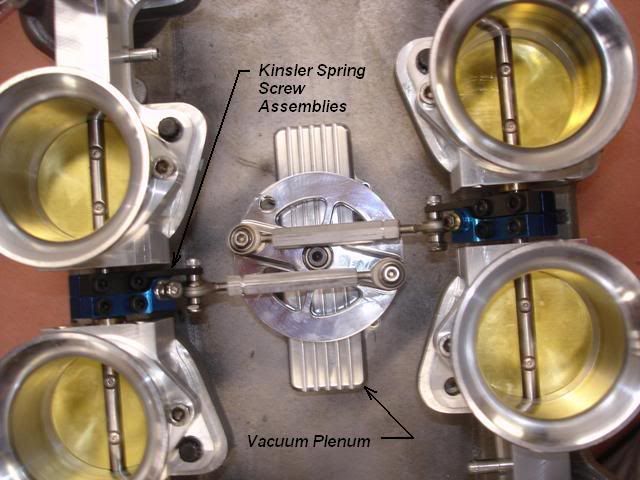
These set ups will fit under a Pantera deck lid with 2" tall filter elements without notching the lid.
quote:In regards to Vacuum. I run an 8” dual diaphragm booster as my master cylinder is 1 1/8” bore, (4 piston rear calipers). I also run a vacuum bottle up front with an extra check valve. I tried supplying vacuum from one port & it was no where near enough. So tried 2 ports, still not enough. Then went to four ports & that was sufficient.
Mixing your comfort accessories with performance is like mixing business with pleasure. I’d recommend running a vacuum pump and separate plenum and circuit for your brake booster and call it a day.
Take care,
Kelly
The system does include coolant temp & RPM.
When we made the new exhaust system we fitted a socket for the O2 sensor.
This was plugged in during the dyno runs to get the correct fuel/air ratio, but the Motec does not use it.
The MAP feeds off of a vacuum port on each throttle body.
I’m pretty sure it’s for atmospheric pressure correction.
The Motec has provision for more sensors & given more time in the future it will be expanded upon to refine the tune.
Inlet air temp sensor is possible, could be fitted above the velocity stacks, or in the side of one.
I also have a cam angle sensor which plugs in where the Distributor was, not set up yet.
There is a spring loaded connection between each throttle body that has a screw adjustment for synchronizing.
I’m not right up on the tuning of this system & I need to learn a lot more.
It’s been a steep learning curve.
I have simply done all of the mechanical side & the manufacture of components etc.
I have a friend who does the electrical & another who has tuned on the Dyno.
So I rely heavily on them for tuning input.
Kelly, your comments here are most helpful, the more information the better.
I like the Kinsler throttle wheel that would give a nice progressive feel.
I did consider a vacuum pump but was trying to get it right using manifold vacuum & reduce the number of electrical accessories.
I may need to chase down an OEM type vacuum pump from a modern car.
We are machining up new rims right now, (17x9.5” front & 19x13” rear).
I have some 8 piston Brembos to put on the front; they tuck nicely in the 17” rims with big Wilwood rotors, so I will need good vacuum supply.
Regards,
Tony.
When we made the new exhaust system we fitted a socket for the O2 sensor.
This was plugged in during the dyno runs to get the correct fuel/air ratio, but the Motec does not use it.
The MAP feeds off of a vacuum port on each throttle body.
I’m pretty sure it’s for atmospheric pressure correction.
The Motec has provision for more sensors & given more time in the future it will be expanded upon to refine the tune.
Inlet air temp sensor is possible, could be fitted above the velocity stacks, or in the side of one.
I also have a cam angle sensor which plugs in where the Distributor was, not set up yet.
There is a spring loaded connection between each throttle body that has a screw adjustment for synchronizing.
I’m not right up on the tuning of this system & I need to learn a lot more.
It’s been a steep learning curve.
I have simply done all of the mechanical side & the manufacture of components etc.
I have a friend who does the electrical & another who has tuned on the Dyno.
So I rely heavily on them for tuning input.
Kelly, your comments here are most helpful, the more information the better.
I like the Kinsler throttle wheel that would give a nice progressive feel.
I did consider a vacuum pump but was trying to get it right using manifold vacuum & reduce the number of electrical accessories.
I may need to chase down an OEM type vacuum pump from a modern car.
We are machining up new rims right now, (17x9.5” front & 19x13” rear).
I have some 8 piston Brembos to put on the front; they tuck nicely in the 17” rims with big Wilwood rotors, so I will need good vacuum supply.
Regards,
Tony.
Attachments
Uh guys, this is getting off-topic a little. I'm interested in IR EFI (Kelly knows that) but I'm also interested to learn about the topic at hand- IDF Webers in a Pantera. George, maybe you could split the thread...
We'll let Corey's thread get back on topic one of two ways.
If one of the members wishing to discuss IR EFI wish to start a new thread on that subject I'll gladly move the appropriate posts to that thread, and the off topic conversation can carry-on over in the new thread.
Or we can just let the off topic coversation end, and allow Corey's thread to stay on topic.
-G
If one of the members wishing to discuss IR EFI wish to start a new thread on that subject I'll gladly move the appropriate posts to that thread, and the off topic conversation can carry-on over in the new thread.
Or we can just let the off topic coversation end, and allow Corey's thread to stay on topic.
-G
Sure George, split it up.
Because there was already some talk on multiple throttle body injection within this thread & the Webbers are so similar I thought I'd add the alternative Injection as well.
Sorry if I screwed the thread up.
regards,
Tony.
Because there was already some talk on multiple throttle body injection within this thread & the Webbers are so similar I thought I'd add the alternative Injection as well.
Sorry if I screwed the thread up.
regards,
Tony.
I take back the part about the thread getting off-course. The IR EFI stuff is great to augment the Weber IDF stuff.
I've been researching IDF's a little more. I am going to order a few books on tuning. I have also researched IR EFI a little more, as well as the standard 4-bbl carburetor. There are so many choices that it's actually fun to think about!
I sent a message to the company that has the manifolds in Australia. I know there are other people who were looking at this manifold and hoping for a group rate or going in on shipping, but I haven't heard any more about it. I am considering using this and IDF Webers or using 2930 Series TWM throttle bodies for IR EFI. Looks like the manifold has a center post that is probably meant for a bell crank or for the wheel approach...
If I do this, I might spring for some AFD heads as well and see about getting it all shipped together.
I've been researching IDF's a little more. I am going to order a few books on tuning. I have also researched IR EFI a little more, as well as the standard 4-bbl carburetor. There are so many choices that it's actually fun to think about!
I sent a message to the company that has the manifolds in Australia. I know there are other people who were looking at this manifold and hoping for a group rate or going in on shipping, but I haven't heard any more about it. I am considering using this and IDF Webers or using 2930 Series TWM throttle bodies for IR EFI. Looks like the manifold has a center post that is probably meant for a bell crank or for the wheel approach...
If I do this, I might spring for some AFD heads as well and see about getting it all shipped together.
I have been looking into IDF's a bit more again for fun.
It turns out there is a local VW shop near where I live (in Salt Lake City) that rebuilds Weber carbs. I talked at length with the guy who rebuilds and tunes Webers, Solex, Zeniths, Delortos, etc. I even compared first-hand IDA and IDF carbs and investigated differences with them both in my hands. If anyone is wondering, the IDF is about 4" tall from bottom to top of carb, not including the main jet extension. IDF's are made to take air filters, have the same jets as IDA's, and have four progression holes instead of the IDA's standard two. While the IDA can have another progression hole drilled, (the so-called "intermediate circuit") the IDF is the true street carb according to the rebuilder/tuner. The rebuilder/tuner seemed to like the Delorto carb that has the same mounting pattern as the IDF, but said that they are no longer being made and scrounging up four 48mm versions all the same would be much more expensive than four brand-new IDF's.
Four 48 IDF's are actually cheaper than four 48 IDA's...
It turns out there is a local VW shop near where I live (in Salt Lake City) that rebuilds Weber carbs. I talked at length with the guy who rebuilds and tunes Webers, Solex, Zeniths, Delortos, etc. I even compared first-hand IDA and IDF carbs and investigated differences with them both in my hands. If anyone is wondering, the IDF is about 4" tall from bottom to top of carb, not including the main jet extension. IDF's are made to take air filters, have the same jets as IDA's, and have four progression holes instead of the IDA's standard two. While the IDA can have another progression hole drilled, (the so-called "intermediate circuit") the IDF is the true street carb according to the rebuilder/tuner. The rebuilder/tuner seemed to like the Delorto carb that has the same mounting pattern as the IDF, but said that they are no longer being made and scrounging up four 48mm versions all the same would be much more expensive than four brand-new IDF's.
Four 48 IDF's are actually cheaper than four 48 IDA's...
It isn't just the height of the carb, you need 48mm clearance over the top of the velocity stack clearance to the deck for proper flow.
The IDA is about 7" to the top of the velocity stack but I think the main advantage of the IDF is that the manifold is lower then the IDA's.
You can run the IDA's with a shortened velocity stack and auxiliary venturi like the Cobra Daytona Coupes did. You can get them down to about 6".
I've done this and it doesn't seem to effect the performance of the carb at all.
I would also say that you can come as close as about 1-1/2" clearance to the decklid.
You could shorten the IDA, cut our the reinforcing to the decklid and probably clear without cutting through the skin.
The IDA is about 7" to the top of the velocity stack but I think the main advantage of the IDF is that the manifold is lower then the IDA's.
You can run the IDA's with a shortened velocity stack and auxiliary venturi like the Cobra Daytona Coupes did. You can get them down to about 6".
I've done this and it doesn't seem to effect the performance of the carb at all.
I would also say that you can come as close as about 1-1/2" clearance to the decklid.
You could shorten the IDA, cut our the reinforcing to the decklid and probably clear without cutting through the skin.
Doug, you might have missed the point of the IDF discussion. Hope this helps:
IDA's need velocity stacks to help the venturi work properly as the guy at the shop I visited said. IDF carbs do not have the same venturi design and should not need velocity stacks. IDF carbs were made to readily accept air cleaners due to the flat top plate. To get an IDA to accept an air filter, you have to use a velocity stack extension and modify it. Please google a Weber IDF and compare the image with your IDA's. They are different carburetors. If you needed the velocity stack, a standard 4-barrel carb would need it too, right? Yes, the velocity stacks create a nice transition for the air to go into the carb to reduce loss of flow, but I would be surprised to see it make a big difference for the street-going average joe with an air cleaner instead of the velocity stack. Give me an air cleaner & better engine longevity any day in trade for a small percentage of power lost.
I held both an IDF and an IDA in my hand yesterday. The IDA is around 1" taller than the IDF. The IDF has a flat top plate, whereas the IDA doesn't. The IDF is 4" tall and the manifold is shorter. The advantage to the IDF is actually the short size, ability to run an air filter without stack adapter, more progression holes for better transition from idle to full throttle, and you can run it under the decklid and engine screen without cutting through the decklid and engine screen.
IDF's will be shorter, even with velocity stacks.
quote:Originally posted by PanteraDoug:
It isn't just the height of the carb, you need 48mm clearance over the top of the velocity stack clearance to the deck for proper flow.
IDA's need velocity stacks to help the venturi work properly as the guy at the shop I visited said. IDF carbs do not have the same venturi design and should not need velocity stacks. IDF carbs were made to readily accept air cleaners due to the flat top plate. To get an IDA to accept an air filter, you have to use a velocity stack extension and modify it. Please google a Weber IDF and compare the image with your IDA's. They are different carburetors. If you needed the velocity stack, a standard 4-barrel carb would need it too, right? Yes, the velocity stacks create a nice transition for the air to go into the carb to reduce loss of flow, but I would be surprised to see it make a big difference for the street-going average joe with an air cleaner instead of the velocity stack. Give me an air cleaner & better engine longevity any day in trade for a small percentage of power lost.
quote:
The IDA is about 7" to the top of the velocity stack but I think the main advantage of the IDF is that the manifold is lower then the IDA's.
I held both an IDF and an IDA in my hand yesterday. The IDA is around 1" taller than the IDF. The IDF has a flat top plate, whereas the IDA doesn't. The IDF is 4" tall and the manifold is shorter. The advantage to the IDF is actually the short size, ability to run an air filter without stack adapter, more progression holes for better transition from idle to full throttle, and you can run it under the decklid and engine screen without cutting through the decklid and engine screen.
quote:
You can run the IDA's with a shortened velocity stack and auxiliary venturi like the Cobra Daytona Coupes did. You can get them down to about 6".
IDF's will be shorter, even with velocity stacks.
Hum. I don't think I missed the point. They are two different carbs.
Not intending to be argumentative, lecturing etc but the point of multiple carbs on an individual runner manifold is for performance.
Everything about the IDF is a compromise system. Why would I want to compromise with less performance?
Sure they look great. In design there is a school of thought that form follows function. If they work...they are beautiful.
So maybe you're right? I don't get the IDF's?
Not intending to be argumentative, lecturing etc but the point of multiple carbs on an individual runner manifold is for performance.
Everything about the IDF is a compromise system. Why would I want to compromise with less performance?
Sure they look great. In design there is a school of thought that form follows function. If they work...they are beautiful.
So maybe you're right? I don't get the IDF's?
Added a new post in my blog about Weber IDF stuff.
If you plan to go for a kind of linkage which will connect the carbs of the two sides by means of a rod, then study the movement of your butterflies closely. I can't properly judge the levers used in the 302 set-up your blog links to, but I found out my original set-up made the butterflies of both sides move in an ansynchronous way. They would close at the same time, and reach WOT at the same time, but midway there was a significant difference. The set-up as I originally had it, is in use though by many people using Webers. Apperently nobody notice(d) this...
Racetep say's that they have the linkage that is center mount with the cable running down the valley of the manifold. It will work just fine with IDF's. They have it for $250, personally I think it's a bit steep.
Add Reply
Sign In To Reply


